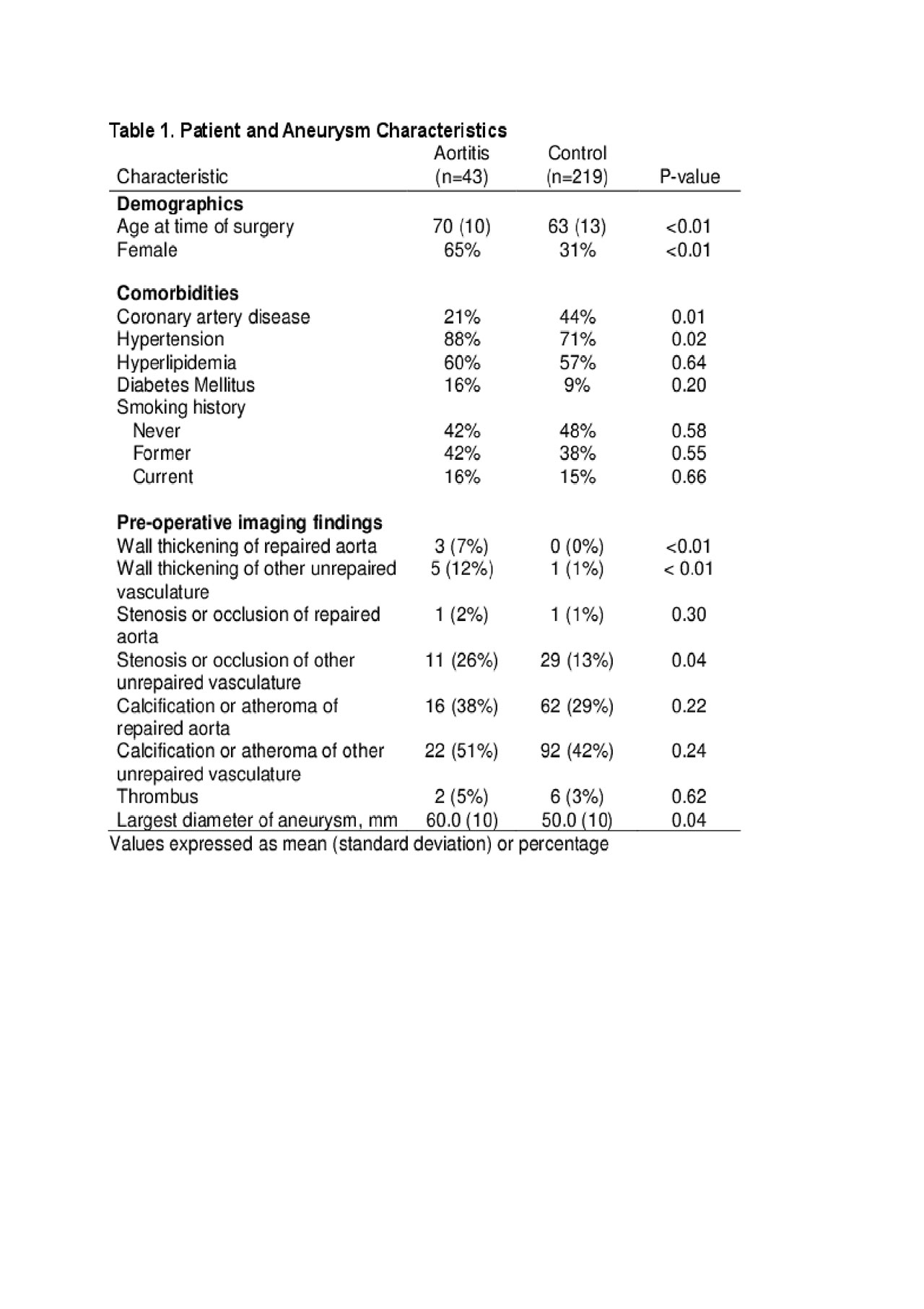Session Information
Date: Tuesday, November 12, 2019
Title: Vasculitis – Non-ANCA-Associated & Related Disorders Poster III: Giant Cell Arteritis
Session Type: Poster Session (Tuesday)
Session Time: 9:00AM-11:00AM
Background/Purpose: Aortitis is challenging to diagnose and is often detected on surgical pathology. A subset of these patients could benefit from early medical therapy as a way to prevent progression of disease or improve surgical outcomes. This study compared pathology-diagnosed aortitis to non-inflammatory aortic aneurysms with respect to pre-operative patient characteristics, laboratory, and imaging data.
Methods: This is a single center matched case-control study. Cases had biopsy-proven aortitis following open thoracic aortic aneurysm repair in the University of Pennsylvania Health System between 2007 and 2017, without evidence of infection or prior known diagnosis or symptoms of rheumatologic disease. Approximately five controls were matched to each case by year of surgical repair and lacked significant inflammation on pathology. Preoperative patient data, such as demographics, comorbidities, laboratory testing and vessel imaging were collected. These were compared between the two groups using conditional logistic regression to evaluate associations between exposures and outcomes. Backward stepwise logistical regression was used to determine factors independently associated with aortitis.
Results: The prevalence of newly-diagnosed aortitis was 4% (total 1,373 aortic surgical specimens reviewed). For the analysis, 262 patients were included: 43 patients with aortitis and 219 matched controls. The ascending aorta was the most common site of surgical repair (95% in both groups). Patients with aortitis were more likely than controls to have granulomatous inflammation (35% vs 0%), giant cells (86% vs 0%), and adventitial inflammation (70% vs 0%). Compared to matched controls, patients with aortitis were older at the time of surgery, more likely to be female, and less likely to have a history of coronary artery disease (CAD). Multivariable analysis revealed that aortitis is independently associated with an older age at the time of surgery (OR 1.08 [95% CI 1.03,1.13], p< 0.01), female gender (OR 2.36 [95% CI 1.01,5.51], p=0.04), absence of CAD (OR 6.92 [95% CI 2.14,22.34] p=0.04), larger diameter of aneurysm (OR 1.74 [95% CI 1.02,2.98], p=0.04), and presence of arterial wall thickening on imaging (OR 56.93 [95%CI 4.31,752.33] p< 0.01).
Conclusion: Among patients who underwent open surgical repair of a thoracic aortic aneurysm, elderly females without a prior history of CAD, those with larger aneurysms at the time of surgery or evidence of vessel wall thickening on imaging were more likely to have underlying aortitis. Patients with these risk factors may benefit from further preoperative screening and assistance in peri-operative management by a rheumatologist.
To cite this abstract in AMA style:
Quimson L, Mayer A, Capponi S, Rea B, Rhee R. Comparison of Aortitis and Non-Inflammatory Thoracic Aortic Aneurysms Undergoing Open Surgical Repair [abstract]. Arthritis Rheumatol. 2019; 71 (suppl 10). https://acrabstracts.org/abstract/comparison-of-aortitis-and-non-inflammatory-thoracic-aortic-aneurysms-undergoing-open-surgical-repair/. Accessed .« Back to 2019 ACR/ARP Annual Meeting
ACR Meeting Abstracts - https://acrabstracts.org/abstract/comparison-of-aortitis-and-non-inflammatory-thoracic-aortic-aneurysms-undergoing-open-surgical-repair/


